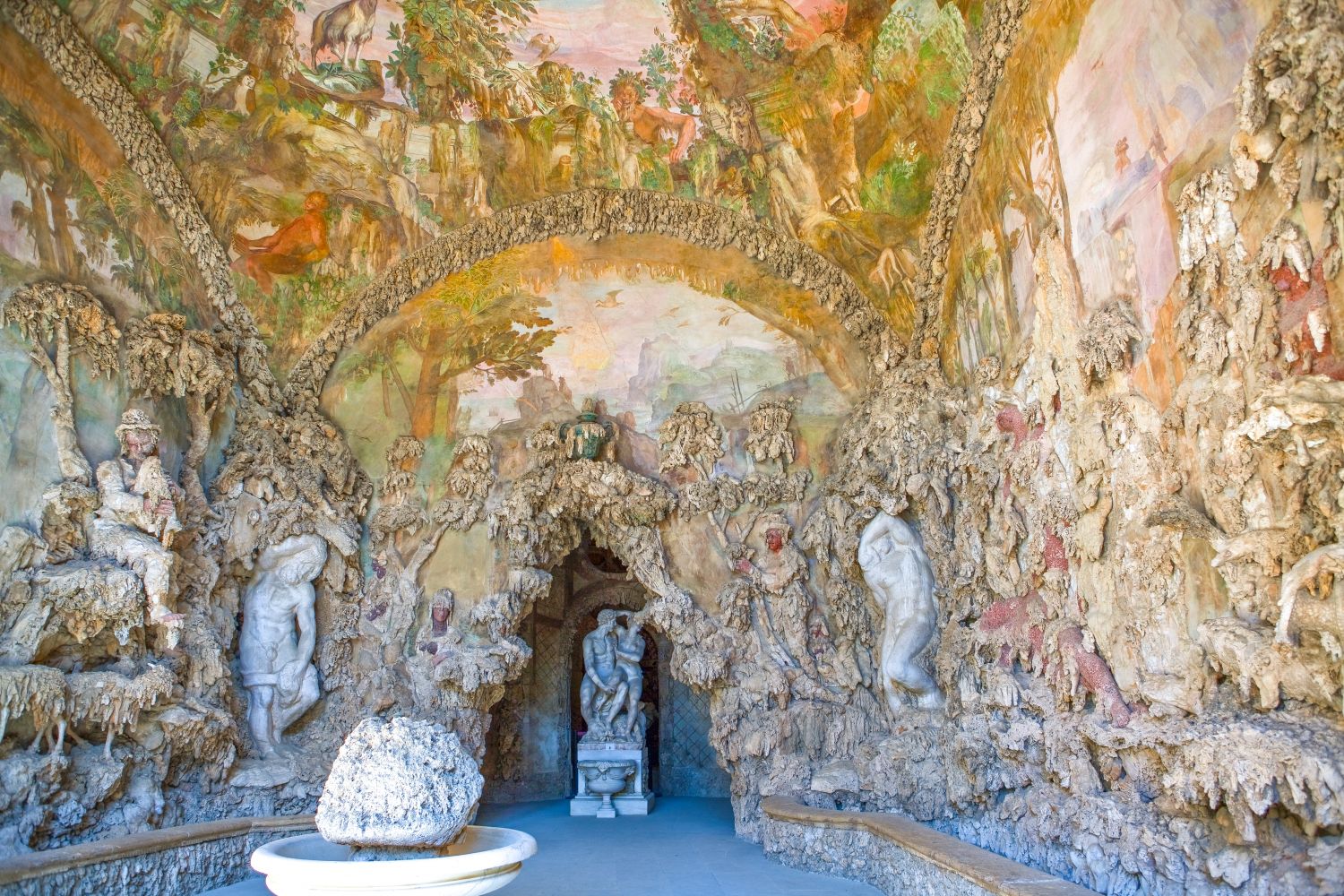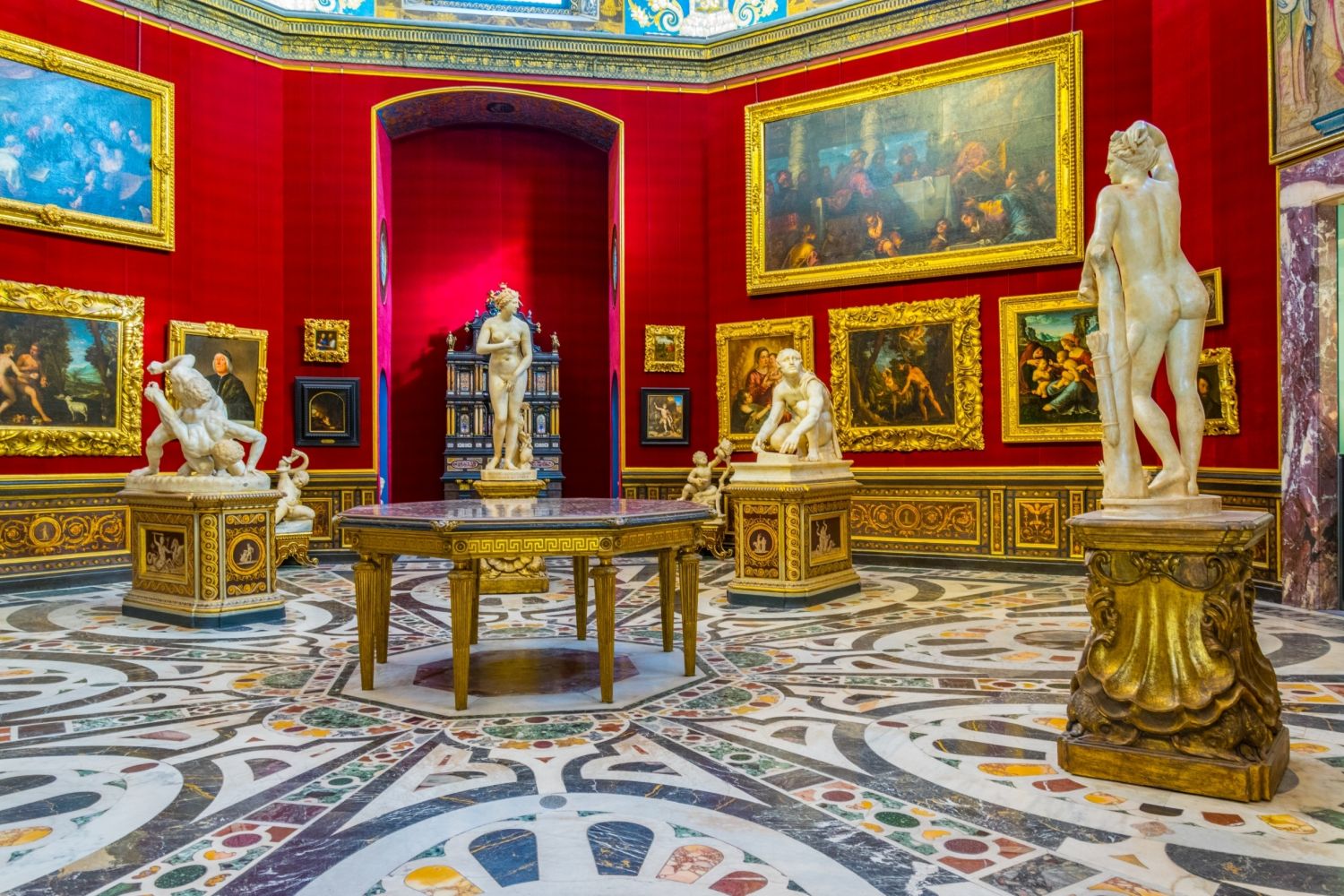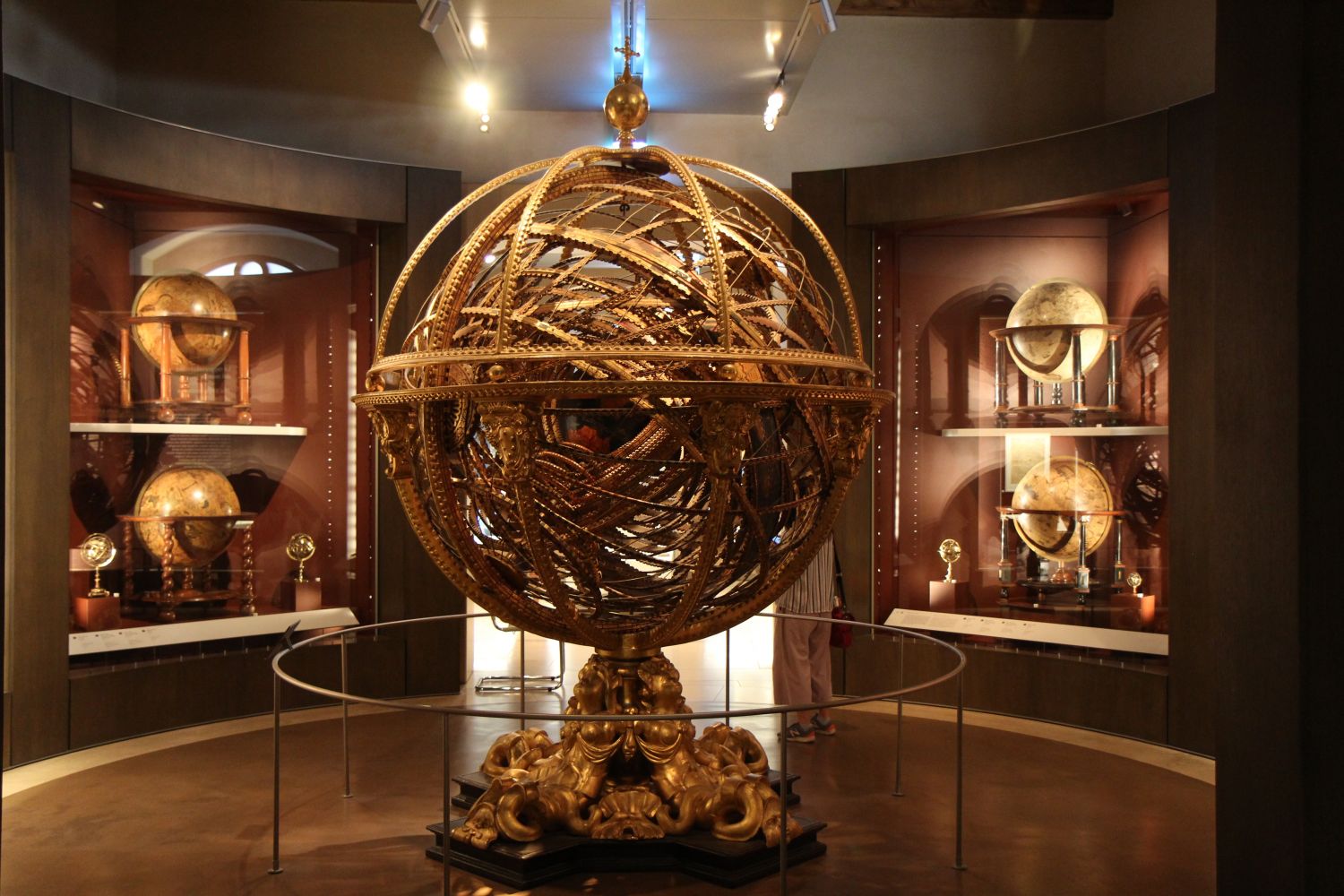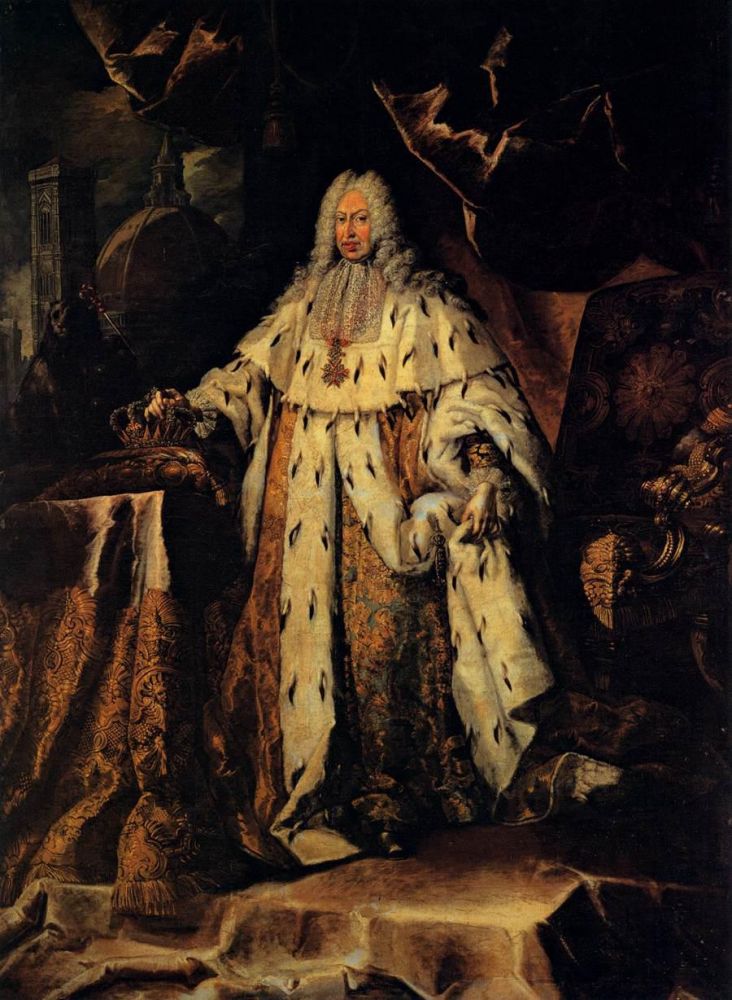
Pitti Palace and Boboli Gardens Tour
A day in court with the Medicis, the Lorraines and the kings of Italy..!
Explore










Let’s try to understand whether or not there is any truth behind the irritating fake news surrounding Gian Gastone, the last Grand Duke of the Medicis! Why don’t we start with some reliable information on this poor, delicate, and thoroughly misunderstood ruler? He is portrayed here by Franz Ferdinand Richter in 1737, just before his death; the portrait is currently housed in the Palatine Gallery (oil on canvas, 320 x 340 cm). I never fail to stop by it during my guided tours of the Pitti Palace and Boboli Gardens. It is extremely significant that its background depicts a hazy Florence at dusk.
I will never tire of remembering that Gian Gastone fought tooth and nail for the remains of Galileo Galilei to be moved. They were removed from his resting place in Santa Croce’s Cappella del Noviziato on 12th March 1737 (where the scientist had been buried almost out of heresy, in secret) to the grand (and well-deserved) mausoleum constructed specially for him. This mausoleum sat in front of Michelangelo’s grave within the same basilica, in the left nave.
It’s also worth briefly mentioning the reasons behind the change in dynasty which took place in Florence. The Lorraine family took over from the Medici family. Long before the death of Gian Gastone, who had no children (neither did his older brother, Grand Prince Ferdinando, who died fairly young, or his sister, Anna Maria Luisa Elettrice Palatina), during the reign of their father Grand Duke Cosimo III, European rulers were discussing how to divide up Tuscany. Its throne would soon be up-for-grabs.
They were offered the chance to occupy Tuscany following the War of the Polish Succession, when King Stanisław Leszczyński of Poland was dethroned. Being him a person of incredibly noble heritage, and father-in-law to Louis XV of France, he was paid back with the Lorraine, on the condition that it would be taken back to France upon his death. Following this, Francis Stephen of Lorraine would be offered the Grand Duchy of Tuscany.
But let’s get back to the final Grand Duke of the Medicis. In the few times he is spoken about, he is often described in somewhat imaginative terms, such as these:
The Grand Duke’s daily life did not exactly follow the rhythms expected of one of the world's most refined courts. Gian Gastone de’ Medici did not love to socialise, and had no ambitions or goals. His work exhausted him and showing his face in public felt like torture. In fact, he only exposed himself to the public during the first few years of his rule, before then locking himself in his apartments, in his bedroom, and finally in his bed, which he categorically refused to leave for months at a time. Whilst confined to his bed, he received ministers and ambassadors, who helped him deal with any official tasks that needed to be done.
For Gian Gastone, it was normal to have lunch in his bed at five p.m. and dinner at two o’clock in the morning; his dogs slept in the bed with him; he stank of wine and tobacco; he would often vomit and release his bowels and bladder in bed; he came up with extravagant ideas such as letting a donkey, acrobats, or bears into his room. The Grand Duke even once had to be rescued from the hands of a troupe of Polish acrobats who he had angered by throwing a glass at their faces when drunk.
Gian Gastone spent his days at homosexual parties organised by Giuliano Dami, who personally took care to recruit boys who were generally of very humble backgrounds. These boys, at the service of the Grand Duke, were called ‘ruspanti’ as they were paid in ‘ruspi’: the coins used by the Grand Duchy of Tuscany, ordered by Cosimo III. It has since been calculated that there were around 370 ‘ruspanti’ in 1731.
There was always a very precise ritual when it came to admitting candidates to become ‘ruspanti’. ‘By way of introduction, Gian Gastone would refer to the boy as ‘sir’, praise him, and check that his teeth were white (because he liked them to have white teeth). He would check that he was blond, check he had good breath, and check that his walk was nonchalant enough. Gian Gastone would then invite the boy to sit on the bed and drink liqueur before checking the virility of his genitalia…’
Anna Maria Luisa, Gian Gastone’s sister, was the one to suffer the most from these bizarre habits. She once managed to convince him to throw a luncheon for the court officials. During this lunch, Gian Gastone got very drunk, started burping continuously, and threw up on the table, cleaning his mouth with the curls of his wig.
The Grand Duke forbade everyone from washing his bed. It was only after the acute embarrassment he felt during a visit from an ambassador (the room had been filled with roses in an attempt to cover the smell), and after his sister-in-law, Violante, fainted when visiting him, that he decided to get up and allow the room to be cleaned.
Because word had spread around Florence that, because of those pitiful conditions, the Grand Duke was on the brink of death, he decided to prove that this wasn’t the case. The Duke requested that he be taken around the city in a carriage during the festival of San Giovanni Battista. To overcome the fear that crowds always instilled in him, Gian Gastone drunk even more than usual, and would lean out of the carriage every so often to throw up. Florentines saw him, with his unkempt wig which he used as a napkin, wrecked by alcohol and, probably, struck by one of the mental illnesses which ran through the Medici family. But in spite of all this, they still cheered for him. (Luigi Gualtieri, Storia della nobile e reale famiglia de' Medici [after 1741], edited by Luca Ombrosi as Vita dei Medici sodomiti, Canesi, Milano 1965)
The legend of perverse debauchery which cloaked the last Grand Duke of the Medicis is recounted even to this day, born of and strengthened by a series of historical, unfortunate circumstances. For a long period, there was nothing written of Gian Gastone. This allowed rumours – which were either completely lacking consistency or grossly exaggerated – to circulate easily. This lack of information was used during the change in leadership that lead to the reign of the Lorraine family, who, at this time, had just come into power. They needed to increase their support levels, both within Tuscany and throughout Italy, and did so even to the detriment of the previous dynasty. However, these ugly myths were never disproved in the years that followed, perhaps because of a lack of interest in the era, which is often only spoken of in comparison with the more interesting reign of Grand Duke Pietro Leopoldo.
During the time of the Italian Unification, or Risorgimento, the figure of the last reigning Medici family member was used as an example of the immorality of tyranny; his debauchery had allowed a section of sacred Italian soil to fall into the hands of a foreigner. Similarly, the lack of concrete knowledge on this topic was never rectified in any studies carried out in later years…Gian Gastone’s whole existence was imagined, or seen only in the light of his final years, about which there was very little information.
There were some particular topics discussed in a few anecdotes which caught the attention of both Italian and overseas travellers, who took the opportunity to create a picture of the Italian dress and customs. It also seems that, to recount the life of the last Medici, the time-tested trick of the ‘rediscovered manuscript’ – which had already been successfully used in literary pieces, such as Manzoni’s “I promessi sposi”, or Stendhal’s “Chroniques italiennes” – was used. Although ancient, manuscripts can be cruel and misinformed.
The reputation of the last Medici therefore originated, perhaps, from a manuscript which was intentionally "offered" instead of ‘rediscovered’.
When Gian Gastone died on 14th July 1737, “things were said publicly around Florence that weren’t particularly pleasant towards the personal servants of the late Grand Duke. In particular, they spoke about Giuliano Dami.” Giuliano Dami, born of extremely humble roots on 14th September 1683, worked for an unknown period as Gian Gastone’s favourite personal servant. The Duke would assign him the task of distributing his donations: an incredibly lucrative task when carried out by someone corrupt. Dami took advantage of this, instigating a lot of hatred. Which ended up overwhelming Gian Gastone alongside Giuliano.
Among other numerous pamphlets that contributed to Giuliano's infamy, one began to circulate, narrating quite a substantial rumour: Dami was accused of having segregated his beloved Gian Gastone, controlling his visitors and turning away any ministers he didn’t like. The servant was also accused of providing the Duke with a wide range and large quantity of individuals of various genders, ages, nationalities, and social standings, who received regular pay in the form of ‘ruspi’ [hence their name, ‘ruspanti’]. These became the Grand Duke’s companions for the orgies referred to above. During this time, a number of horrific stories about the Duke’s lifestyle and sexual, hygiene, and eating habits came to light.
The copies made and circulated of this manuscript, which was considered useful in terms of bureaucracy during the reign of the Lorraine family, must have been numerous, as proven by the number of both direct and indirect copies remaining today…
But this isn’t to deny the existence of the ‘ruspanti’, who appear in historical documents dating as far back as 1729 as well-known figures. It also doesn’t deny the fact that Dami had a certain influence on the Grand Duke, having also potentially been his lover… But we must also consider bringing the figure of Gian Gastone de’ Medici back to life in more realistic dimensions. His gambling addiction, among other ailments, meant that the Duke was not able to make the most of his talents, particularly his endless musical and scientific culture, especially during his later, more infamous years. He was so well-read, in fact, that he was said to be “enlightened and without prejudice”.
He was born into a family of rulers without having even the smallest taste for control or ostentation…From an early age, he had been forced into the shackles of etiquette. He lived through a period in which rulers of small and mid-size territories were easy prey for the more powerful and violent states. He wasn’t cut out for great energy or ambition, but was bound by his father’s wishes, supporting him in his efforts…In fact, he represented the best of his family outside the Grand Duchy, and fought with dignity until the very end – despite his physical decadence and his knowledge of how futile the battle was. In his opinion, they had already lost. He fought so that the Grand Duchy would be spared from a war within its own borders, and would be able to maintain its identity and its reign, although not under the Medici name.
In an attempt to stay loyal to a neutral political stance which would prevent war, and juggling between Spain and the Empire, Gian Gastone fervently pointed out to the rulers of Europe that the Tuscan succession had to take place “in a quiet and friendly manner”. He explained that the Florentine population would not recognise the acts approved in Vienna, which reduced the Grand Duchy to a feud with the Empire.
After his death, Gian Gastone became shrouded in a depraved reputation that he perhaps didn’t deserve. Maybe we needed to attempt to get to know him a little more personally.
(P. URBANI, Il Principe nelle reti. Tutto è forza d'una fatale necessità, in Gian Gastone [1671-1737]. Testimonianze e scoperte sull'ultimo Granduca de' Medici, exhibition catalogue [Firenze, Museo delle Cappelle Medicee july 16th - november 2nd, 2008] edited by M. Bietti Favi, Firenze 2008, pp. 21-140, pp. 109-114).
Lunedì 06 settembre 2021
